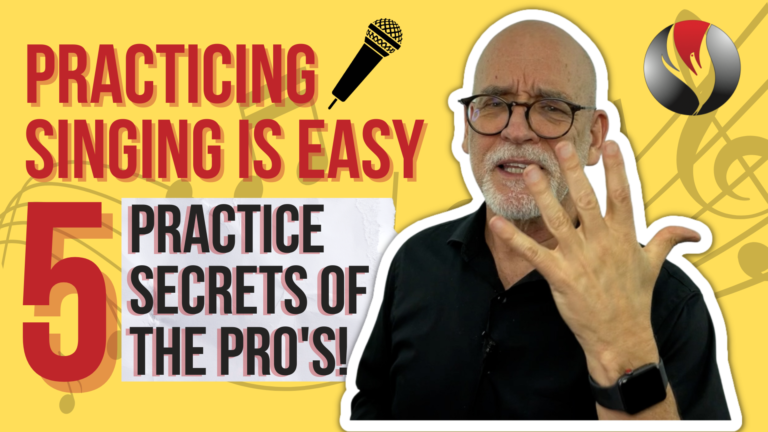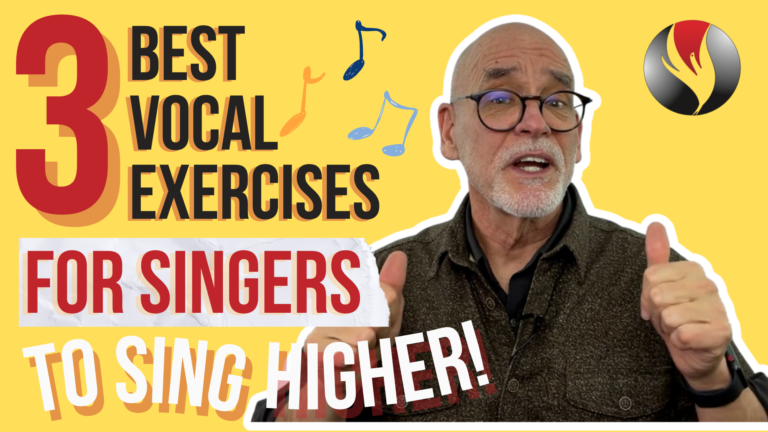“How to Train My Voice to Sing Higher” is a series of videos with tips designed to help you succeed as a singer.
Even the most experienced singers fall back into old habits of pulling chest, gripping, grabbing or tensing up. This is especially true when singing for an audience.
Inside this video, I’m going to give you another advanced exercise using the “ney” that helps prepare you for singing songs without tension. Here we go!
How to Train My Voice to Sing Higher
The exercise is “ney” with the 1 ½ scale. The 1 ½ scale is more like a song because it travels between chest and head voice. This is more challenging because it requires you to transition from chest voice, through the first bridge of your voice into head voice and back down to chest.
Men start on the Bb2 and women on the F below Middle C. Go up 3 half-steps and return to the starting note. Like this.
Men I’ll demonstrate it once and then you go ahead. [Demo] Ladies. [Demo]
This takes you through the first bridge of your voice. Once you are able to do this successfully you can do this exercise higher.
How to Train My Voice to Sing Higher – Tips for Ney and the 1 ½ Scale
Here are some tips for the ney and the 1 ½ scale.
-
Do this exercise gently at medium volume.
-
Keep the volume the same from bottom to top and back. Don’t get louder as you sing higher. [Demo]
-
If the vocal cords disconnect add a slight bratty or witchy sound to the ney. [Demo]
If your vocal cords disconnect or you are below the pitches at the top, bend 90 degrees at the waist and look at the floor as you do the scale. Start bending when you start the scale so you’re bent over at the top note. [Demo]
Benefits of the Ney and 1 ½ Scale
Here are some benefitsof the 1 ½ scale with the ney. It:
-
Balances and Coordinates the vocal cords with the air flow.
-
Reduces the vibrating mass of the vocal cords as they stretch and tense as the pitch goes up.
-
Helps you feel the shifting resonance from chest into the head cavities and back.
-
Trains you not to reach or squeeze as you sing higher.
-
Keeps the vocal cords connected from chest into head voice and back.
-
Disengages the outer squeezing muscles so the internal vocal cords work freely and easily.
-
Prepares you to sing songs with more confidence.
This appears very simple. But it has a powerful impact on our singing. It helps us understand and train our voices to sing higher.
Understanding your vocal type also helps you train your voice. Do you know your vocal type? I’m not referring to your vocal range, like soprano, alto, tenor or bass.
Your vocal type is what you tend to do when you sing. For example, do you tend to pull up chest voice? Do you tend to tense or crack as you sing higher.
Visit PowerToSing.com and take the vocal test, which I call the PowerTest. Take the quiz and discover your vocal type. Then visit the Knowledge Center and watch the videos about your vocal type.
Download the free exercises for your vocal type and start working on them. They will help balance and coordinate your unique voice. This opens the door to the upper range in your voice.
I’m Chuck Gilmore with Power To Sing. You can sing higher with beauty, confidence and power.
I’ll see you inside the next video.









Responses
Thanks Liv, I’m glad it helped!
Thank you! I’ve been singing for years but the bending trick helped me realize how differently it feels when I sing correctly on the high notes. 🙂